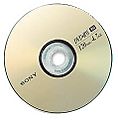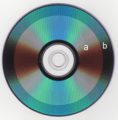DVD facts for kids
A DVD (which means Digital Versatile Disc or a Digital Video Disc) is an optical disc capable of storing up to 4.7 GB of data, more than six times what a CD can hold. DVDs are often used to store movies at better quality than a VHS. DVDs can also have interactive menus and bonus features such as deleted scenes and commentaries. Like CDs, DVDs are read with a laser.
The disc can have one or two sides, and one or two layers of data per side; the number of sides and layers determines how much it can hold. A 12 cm diameter disc may have one of the following storage capacities:
- DVD-5: single sided, single layer, 4.7 gigabytes (GB), or 4.38 gibibytes (GiB)
- DVD-9: single sided, double layer, 8.5 GB (7.92 GiB)
- DVD-10: double sided, single layer on both sides, 9.4 GB (8.75 GiB)
- DVD-14: double sided, double layer on one side, single layer on other, 13.3 GB (12.3 GiB)
- DVD-18: double sided, double layer on both sides, 17.1 GB (15.9 GiB)
There are also 8 cm DVDs with a storage capacity of 1.5 GB.
The capacity of a DVD-ROM can be visually determined by noting the number of data sides, and looking at the data side(s) of the disc. Double-layered sides are usually gold-colored, while single-layered sides are usually silver-colored, like a CD. One additional way to tell if a DVD contains one or two layers is to look at the center ring on the underside of the disc. If there are two barcodes, it is a dual layer disc. If there is one barcode, there is only one layer.
DVD data storing
Both CD and DVD discs have equal sizes (diameter, thickness etc.). However, the amount of information they can store is different. These discs are made of the same materials and have the same methods of production.
CDs and DVDs use the same way of keeping information. Both CDs and DVDs have pits and bumps on the data track (the data track represents a path which has certain information). The information is read by a laser.
A DVD disk has several layers, which are made of plastic. All layers have a thickness of 1.2 millimeters. An injection used on a polycarbonate plastic leads to the creation of microscopic bumps. Today's production uses this type of plastic to create different things because it can resist very high and low temperatures.
When layers are made, the bumps appear. Many bumps form one continuous spiral that can include information. After that a spray of a special reflective layer covers the bumps.
Aluminum is applied behind inner layers and semi-reflective gold covers the outer layers. This helps the laser to concentrate through the outer layers onto the inner ones. Then, after applying a protective liquid (lacquer) and pressing the layers, they are treated with infrared light.
Tracks on a DVD
Every track on a DVD disk circles from its center to the edge. The distance between the tracks on a DVD disk is 740 nanometers. Only a very precise mechanism can read the bumps on the disk, because they are very small (320×400×120 nanometers). The aluminum side of the disk has pits, but the side which is read by the laser has bumps. Because the size of the bumps are very small, a DVD track is very long. A data track of a DVD layer is about 7.5 miles long. This is the length of an ordinary DVD disk. The track of a disc with two sides would be about 30 miles long.
Images for kids
-
PlayStation 2, the first video game console to run DVDs.
-
Scan of a DVD-R; the "a" portion has been recorded on while the "b" portion has not. It may be less obvious in CD-Rs and BD-Rs.
See also
 In Spanish: DVD para niños
In Spanish: DVD para niños











